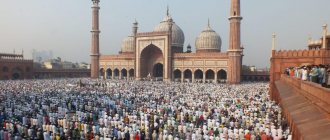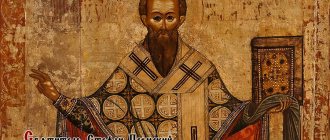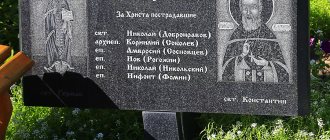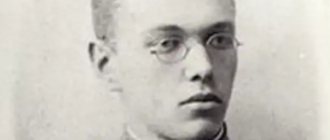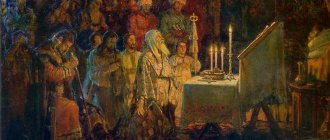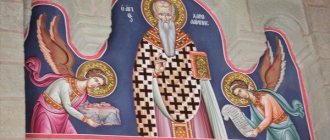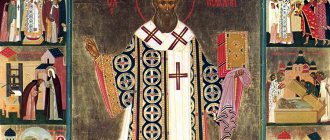| St. Ignatius (Brianchaninov) |
Ignatius (Brianchaninov)
(1807 - 1867), Bishop of the Caucasus and Black Sea, saint. Famous Russian ascetic and spiritual writer of the 19th century Commemorated on April 30, in the Cathedrals of Bryansk, Valaam, Vologda, Kostroma, Rostov-Yaroslavl and St. Petersburg saints
In the world, Dmitry Alexandrovich Bryanchaninov, was born on February 5 [1] 1807 in the village of Pokrovskoye, Gryazovets district, Vologda province, and belonged to the old noble family of the Bryanchaninovs. Its ancestor was the boyar Brenko Mikhail, squire of the Grand Duke of Moscow Dimitri Ioannovich Donskoy. Chronicles report that Mikhail Brenko was the same warrior who, in the clothes of the Grand Duke and under the princely banner, heroically died in the battle with the Tatars on the Kulikovo Field.
The father of the future Saint, Alexander Semenovich Brianchaninov, preserved good old customs in his family. He was a faithful son of the Orthodox Church and a zealous parishioner of the church he built in the village of Intercession. Bishop Ignatius's mother was an educated, intelligent woman. Having married very early, she devoted her life entirely to her family.
Studies
All the Bryanchaninov children received an excellent home upbringing and education. Dimitri's teachers and mentors were amazed at his brilliant and versatile abilities, which were revealed at a very early age. When the young man was 15 years old, his father took him to distant St. Petersburg and sent him to the Military Engineering School. The future planned by the parents did not at all correspond to Dimitri’s moods; He had already told his father that he wanted to “become a monk,” but the father dismissed this unexpected and unpleasant desire of his son as an inappropriate joke.
The excellent preparation and exceptional abilities of the young Brianchaninov were already evident during the entrance exams to the School: he was accepted first in the competition (out of 130 examined for 30 vacancies) and was immediately assigned to the second class. The name of the talented young man became famous in the royal palace. Throughout his stay at the school, the future Saint continued to amaze his mentors with brilliant successes in the sciences and was the first on the list to graduate from a full course of science in 1826.
At the School, Brianchaninov became the head of a circle of admirers of “holiness and honor.” His rare mental abilities and moral qualities attracted professors and teachers of the School and fellow students to him. He became famous throughout St. Petersburg. Emperor Nicholas I treated him with special fatherly attention and love; Taking a very active part in the life of the future Saint, he repeatedly talked with the young man in the presence of the Empress and children.
Origin, upbringing and family ties opened the doors of the most aristocratic houses in the capital for him. During his years of study, Dimitri Brianchaninov was a welcome guest in many high society houses; he was considered one of the best readers and reciters in the house of the President of the Academy of Arts A.N. Olenin (his literary evenings were attended, among others, by A.S. Pushkin, I.A. Krylov, K.N. Batyushkov, N.I. Gnedich). Already at this time, the extraordinary poetic talents of St. Ignatius were revealed, which subsequently found expression in his ascetic works and gave many of them a special lyrical flavor. The literary form of many of his works indicates that their author studied Russian literature in the era of Karamzin and Zhukovsky and subsequently expressed his thoughts in beautiful literary Russian.
In 1826, Dimitri graduated from the Military Engineering School. A brilliant secular career was opening up before the young man, but he submitted his resignation, wanting to become a monk. The request was not granted, and Dmitry Alexandrovich went to serve in the Dinaburg fortress, where he became seriously ill and was soon released from worldly labors.
Monasticism
Upon recovery, he entered the Alexander-Svirsky Monastery as a novice. Then he moved with his elder, Hieromonk Leonid (Leo) to Optina Pustyn.
On June 28, 1831, he was tonsured a monk by Bishop Stefan (Romanovsky) of Vologda in the Resurrection Cathedral in the city of Vologda, with the name given in honor of the Hieromartyr Ignatius the God-Bearer.
On July 4 of the same year he was ordained a hierodeacon, and on July 25 - a hieromonk.
Soon he was appointed abbot-builder of the Pelshem Lopotov Monastery.
On January 28, 1833, he was elevated to the rank of abbot. He soon becomes famous for his administrative successes.
Having been appointed abbot of the Nikolo-Ugreshsky Monastery, without taking office, he was summoned to St. Petersburg, where, by Imperial order, he was assigned to become the archimandrite of the Trinity-Sergius Hermitage near St. Petersburg [2].
Sergiev Pustyn
By the time Archimandrite Ignatius was appointed rector, the Trinity-Sergius Hermitage, located on the shores of the Gulf of Finland near St. Petersburg, had fallen into severe desolation. The temple and cells fell into extreme disrepair. The small brethren (15 people) were not distinguished by strict behavior. The twenty-seven-year-old archimandrite had to rebuild everything from scratch. The monastery was built up and decorated. The worship performed here became exemplary. Monastic melodies were the subject of special care of Archimandrite Ignatius; he took care of the preservation of ancient church melodies and their harmonization. Famous church composer Fr. Pyotr Turchaninov, who lived from 1836 to 1841 in Strelna, next to the Trinity-Sergius Hermitage, conducted, at the request of Fr. Ignatius, classes with the monastery choir and wrote some of his best works for him. M.I. Glinka, who enthusiastically studied ancient church melodies in the last years of his life, also wrote several chants for this choir.
During his stay in the desert, he personally communicated and corresponded with many figures of Russian spiritual and secular culture. Archimandrite Ignatius also corresponded with his spiritual children (about 800 such letters from the Saint are now known)
At the Caucasian department
He was elected Bishop of the Caucasus and Black Sea. Metropolitan Grigory (Postnikov) of St. Petersburg insisted on the elevation of Archimandrite Ignatius to the rank of bishop in the Caucasus See, who took a friendly and sincere part in it, based on spiritual unity [3].
The consecration took place on October 27, 1857 in the Kazan Cathedral in St. Petersburg.
The path to the Caucasus ran through Moscow, Kursk and Kharkov (railway connections were then only between St. Petersburg and Moscow, then it was necessary to travel on horseback).
Bishop Ignatius arrived in the cathedral city of Stavropol on January 4, 1858. Civil governor P. A. Brianchaninov (the saint’s brother), together with the mayor, clergy and people, solemnly greeted the new archpastor upon entering the city. The first words uttered by the ruler on Stavropol soil were: “peace to this city.”
| St. Ignatius (Brianchaninov) |
Vladyka Ignatius was the third in order bishop of the Caucasus and Black Sea.
The external conditions of religious life in this newly established huge diocese were extremely different from everything that he had to deal with before his appointment to the Caucasus. The Caucasian War continued. The multinational and diverse composition of the local population was the reason for the emergence of many such issues of a church-administrative nature, the likes of which were not even imagined by the bishops who managed the well-appointed dioceses in the center of the state. The saint saw his most important task in apostolic service to his flock, in pacifying the world in the fire-breathing Caucasus, in strengthening and expanding Holy Orthodoxy here. He zealously cared about the organization of worship, about normal relations between the clergy and the laity, about improving the life of the clergy, and raising their educational level. Soon diocesan affairs were brought to a prosperous state.
At St. Ignatius, the Stavropol Theological Seminary, founded in 1846, experienced a period of rapid prosperity, for the Bishop invested all his strength in the construction of the theological school. He personally observed the spiritual growth of the students and moved the seminary to a new spacious building.
St. Ignatius made detours around the diocese, the borders of which were the shores of the Black, Azov and Caspian seas, the snowy peaks of the main Caucasus ridge and the distant dry Kalmyk steppes. The Caucasian War was going on, and the bishop on the road constantly had a monstrance with him for, perhaps, the last Communion.
His Grace Ignatius attached great importance to the construction of churches of God in the diocese. Through his care, in 1859, the St. John-Marinsky community, founded by the first Bishop of the Caucasus Jeremiah, was transformed into a monastery. In the same monastery in 1861, the Right Reverend Ignatius founded the new Church of the Intercession. Vladyka, together with the provincial architect Voskresensky, himself drew up a design for a temple in the village of Novo-Grigorievskoye, which became the decoration of the Diocese. In 1860, Bishop Ignatius issued a charter for the construction of a new temple in Mozdok in honor of the miraculous Iveron Icon of the Mother of God, located in this city and deeply revered in the Caucasus. With the blessing of the Saint, in two years (1859-1860) a unique bell tower of the Stavropol Cathedral of the Kazan Icon of the Mother of God was built according to the design of P. Voskresensky.
Bishop Ignatius ruled the Caucasian diocese for a short time—less than four years—but this time providentially coincided with many important events in the life of the Caucasus. In August 1859, Imam Shamil was captured. In 1860, the Caucasian line was divided into the Kuban and Terek regions. In 1861, the settlement of the Trans-Kuban region began.
Despite military operations and the real danger of being taken hostage or killed, the saint visited many parishes from Taman to Kizlyar, put the diocesan administration bodies in order, achieved an increase in salaries for the diocesan clergy, introduced solemn worship, organized a wonderful bishop's choir, and built a bishop's house. In addition, he preached tirelessly. Strict with himself, he was lenient towards the infirmities of his neighbors.
Retirement
A serious illness forced Bishop Ignatius to submit a petition for retirement in the summer of 1861.
By the definition of the Holy Synod of August 9, 1861, No. 1752, he was assigned to stay “ in the Nikolaev Babayevsky Monastery of the Kostroma diocese, which was provided to the Right Reverend Ignatius in the main administration so that the abbot and brethren of the monastery would have the same relationship with him as if they were with the diocesan His Eminence, with the use of the best cells, heating, lighting, servants and crew, but without the regular maintenance of the monastery
» [4].
In October he arrived at the Nikolo-Babaevsky Monastery along with several devoted students. Here he led a solitary prayer life, created many famous works (“Offering to Modern Monasticism”, “The Fatherland”, etc.), and continued correspondence with spiritual children
On April 16, 1867, on the first day of Easter, he celebrated his last Liturgy.
Died on April 30, 1867. About five thousand people attended his funeral service, whose sadness was “dissolved by some incomprehensible joy.”
Memory and veneration
Assessments of the life and works of St. Ignatius
Ep.
Nikodim (Kazantsev) (1803 - 1874): I know Fr.
Ignatius: a monk without flattery and hypocrisy [5].
Igum. Nikon (Vorobiev) (+ 1963):
Today is the birthday of our beloved Ignatius (Brianchaninov). How grateful I am to him for his writings! Not understanding and not appreciating it means not understanding anything in spiritual life. I dare to say that the works of Bishop Feofan (Govorov) (may the Holy Bishop forgive me) are the works of a schoolboy compared to the works of Bishop Ignatius (Brianchaninov).
This is what I would like to wish you most dearly, if you asked me: constantly delve into Ignatius (Brianchaninov) and follow the path indicated by him. This is the path of all the ancient fathers, the path traveled by Ignatius himself, tested by him as a man of our time, development, a man of our shortcomings and weaknesses, of our almost surroundings. This is what makes his writings especially valuable. Add to this the power of God’s grace, clearly palpable in them, for they were written not arbitrarily, but according to a special inspiration
[6].
| Saint Ignatius (Brianchaninov) |
St.
Ignatius was well known and appreciated by the leading member of the Holy Synod, Metropolitan of Moscow Filaret (Drozdov). Many outstanding people of Russia sought acquaintance with Archimandrite Ignatius, his advice and instructions. Among them are N.V. Gogol, F.M. Dostoevsky, A.A. Pleshcheev, Prince Golitsyn, Prince A.M. Gorchakov, Princess Orlova-Chesmenskaya, hero of the Crimean War, naval commander Admiral Nakhimov. Admiring the way of life and work of Saint Ignatius, the famous Russian writer N.S. Leskov dedicated his story “Unmercenary Engineers” to him. Everything about the Saint captivated his contemporaries: his majestic appearance, nobility, special spirituality, sedateness and prudence. He spiritually nourished his large flock, promoted the moral perfection of people who sought God, and revealed the beauty and greatness of Holy Orthodoxy. Many-sided experience, a special gift for looking at everything spiritually, deep insight, constant and accurate self-observation made him very skillful in treating spiritual and mental illnesses. This is whose prayerful help modern patients should resort to, and not to psychics and sorcerers, charlatans and “witch doctors.”
Sensitive to any falsehood, Saint Ignatius noted with bitterness that the object of depiction of secular art is, first of all, evil. He was sharply critical of literary works that glorified the so-called “superfluous people”, “heroes” who do evil out of boredom, like Lermontov’s Pechorin and Pushkin’s Onegin. Considering that such literature causes serious harm to the inexperienced souls of reading youth, the Saint wrote in 1847 for mass publication a sacred story about the Old Testament biblical hero - the righteous Joseph, the image of purity and chastity [7]. In the preface to the story, he wrote: “We wish that many of Pechorin’s followers would turn into Joseph’s followers.”
Interest in the personality and immortal works of Bishop Ignatius does not fade even today. Saint Ignatius Brianchaninov is the best spiritual leader, the best example of how in the whirlpool of life a person can remain faithful to Christ, constantly kindling in his heart the fire of love and devotion to God.
Praise
Bishop Ignatius was canonized on June 6-9, 1988 at the Local Council of the Russian Orthodox Church in the Trinity-Sergius Lavra. His holy relics were placed in the Holy Vvedensky Tolga Monastery in Yaroslavl, and a particle of them was brought to Stavropol by Patriarch Alexy II of Moscow and All Rus' during the first visit of the Primate of the Russian Orthodox Church to the Caucasus in August 1994.
The first church in the name of St. Ignatius was erected in 1995 in Donetsk in Ukraine, the second in 2013 in the city of Gryazovets in the Vologda region.
Troparion, tone 8
Champion of Orthodoxy,/ a great worker and teacher of repentance and prayer,/ Divinely inspired adornment of the bishops,/ glory and praise to the monastics,/ you have made us all chaste in your writings./ The spirit of the monk Dear Ignatius, God-wise, / pray to the Word of Christ God, / Whom you carried in your heart ,/ grant us repentance before the end.
Ignatius Brianchaninov: holy aristocrat
Estimated reading time: 14 minutes.
Saint Ignatius Brianchaninov (1807–1867) is one of the most significant, bright, and sometimes even controversial thinkers and theologians of the 19th century. He was a “spiritual aristocrat,” a conservative, a man who remained completely alone all his life, tragically falling out of touch with the realities of his time.
About his theological and social thoughts, about the era in which the fate of the saint unfolded, “Thomas” spoke with Doctor of Theology, Dean of the Faculty of Theology of PSTGU, priest Pavel Khondzinsky .
The middle of the 19th century - the period of the most active ministry of St. Ignatius - is the time of the formation of the intelligentsia, with its questions, problems, and searches. How did the “seeking public” relate to the Church? Was there a dialogue between the intelligentsia and the clergy?
In order to answer this question, it is necessary to go back - to the beginning of the 18th century, during the time of Peter the Great's reforms. What happened in the country after their implementation in practice (and “on paper” Peter wanted to see the country enlightened in a European way) can be called a social breakdown. The emperor hoped that cultural transformations would affect all layers of society. But, as in many other transformations, he failed to complete his plans.
European culture and way of life penetrated only into the upper strata of society. At the same time, the very mental content of this culture was no longer sacred, not church, since the process of secularization (separation of public and private life from the Church) in Europe at that time was completed. A model of secular culture and life has emerged in which a person’s relationship with God is his personal matter. In this form it penetrated into Russia. And if the elite learned it after some time, then the Russian people for the most part remained in the old, pre-Petrine way of life. A situation has arisen that could be called “double existence.”
At the same time, in addition to this socio-cultural stratification, there was also a class stratification. As a result, the clergy became isolated in a special closed class with its own unshakable foundations, traditions, and principles. If earlier bishops often came from noble families (for example, the Moscow saints Alexy and Philip came from boyar families), then the Russian bishops of the Synodal era already came from the clergy class.
Greek Catholic Theological Seminary. XVIII century
What was the social elevator like within this class group? Spiritual education. The person entered the seminary, then the academy. After successful completion, the graduate was offered to remain at the seminary either as an inspector or as a teacher. In the future, he could rise through the ranks all the way to the rector. At the same time, he accepted monasticism and thus became a ready candidate for bishop. And having already become a bishop, such a person, according to Peter’s “Table of Ranks,” was equated in status to a general, which means he had access to the highest strata of society.
Here, however, another problem arose. The fact is that European universities have always had theological faculties in their structure - unlike Russian ones, which began to appear in the 18th century and never had theological faculties. And this provoked in Russia another division between educated society and the clergy, since spiritual (that is, theological) education could only be obtained by belonging to the clergy. Saint Ignatius Brianchaninov himself, by the way, suffered a lot in connection with this, which I will talk about later.
Baptism. Engraving 1811
It turned out that the highest circles of society, who received a secular education and lived a European cultural way of life, spoke different languages with the clergy, who had a special spiritual education and preserved the pre-Petrine, sacred foundations of life. In addition, a paradoxical situation arose in the relationship between parishioners from society and the clergy. In fact, the educated flock looked down on their shepherd, the priest.
That is, those whom we might call the intelligentsia generally looked down on the priests and the Church?
In general, yes. In this regard, one characteristic story is known. Metropolitan Platon (Levshin) (1737–1812) taught the Law of God to the future Emperor Paul I. And when Paul became emperor, he decided to thank his teacher with a state award - an order, which in principle was not accepted. The clergy did not receive such secular awards. Metropolitan Platon himself was terribly upset that now, in his old age, he would be so “disgraced.” He asked Paul to retract his decision. And then the emperor decided to seek advice from Ivan Vladimirovich Lopukhin, a famous spiritual writer, senator, and freemason. Pavel asked him whether it was possible to give orders to bishops. The senator replied that, in general, of course, it is not appropriate, such awards do not suit the bishops of the Church of God, but the current Church is no longer quite a Church, and the current bishops are more administrators than clergy, so there is nothing wrong with that. It seems to me that this incident clearly illustrates how educated society in general perceived the clergy.
Metropolitan Platon (Levshin)
There were, of course, exceptions. For example, Saint Philaret (Drozdov; 1783–1867), whom the common people loved, and who was respected both among educated people (Peter Yakovlevich Chaadaev, for example, greatly valued communication with him), and in high society. It is known that almost all foreign ambassadors who came to Moscow considered it their duty to introduce themselves to the Moscow Metropolitan - this was a gesture of respect for a specific person.
Saint Philaret (Drozdov). Artist V. Gau, 1854
In general, the attitude towards the church clergy was contemptuous. This was later superimposed on by another process. At the beginning of the 19th century, a theology of the laity began to take shape. In the secular environment, people appeared who were interested in theological problems. Without a seminary base, they began to theologize at their own peril and risk. In addition, they developed a sharply negative attitude towards academic theological education. And most of all they were outraged by the thesis that there is a so-called “Teaching Church.” It turned out that the same spiritual class, which was treated so condescendingly, was in relation to educated people - in the position of a mentor and teacher. That is why some lay believers began to build their own, if you will, “alternative” in relation to spiritual-academic theology. One of the striking examples is Alexey Stepanovich Khomyakov, who in his theological works firmly insisted that in the Church the primary place belongs not to the spiritual hierarchy, but to the community. In addition, at the same time, Russian writers and poets began to develop the idea of their prophetic destiny - in fact, perhaps, this is where the idea of the special role of the Russian intelligentsia originates. Nikolai Vasilyevich Gogol worked a lot here, paving the way for others in this regard.
Religious and philosophical meetings. D. S. Merezhkovsky, Z. N. Gippius, D. V. Filosofov. Photo early 20th century
In a word, we are faced with a whole tangle of various problems, processes that ultimately led to a radical misunderstanding between the Church and educated society. A mental and value gap formed between them, which could not be overcome, and when at the beginning of the 20th century the so-called “Religious and Philosophical Meetings” were held, designed to establish a dialogue between the Church and the intelligentsia, in the end the idea failed and everyone remained with their own.
What, in this case, particularly distinguished Saint Ignatius Brianchaninov from other religious and theological thinkers of the 19th century? Why was such close attention directed at him?
Many features of the saint’s fate were precisely determined by what we talked about above. Saint Ignatius was one of the few exceptions at that time. He belonged to the upper social classes. His father was a page (a person in the court guard service) under Emperor Paul I. At the insistence of his father, the future saint entered the Military Engineering School in St. Petersburg - one of the most elite at that time. Dmitry (his worldly name) was familiar with the high society of that time: with Alexander Pushkin, with Vasily Zhukovsky, with the great princes, with the future Emperor Nicholas I. But despite the fact that Dmitry was completely involved in social life from childhood, he was drawn to monasticism. And when, already as a student, he finally decided to go to a monastery, an episode characteristic of his life occurred. Grand Duke Mikhail Pavlovich was entrusted with dissuading the young man from this step. Having met the young man, he told him that “it is much more honorable to save your soul while remaining in the world” - the thought in itself was not seditious. But the future saint answered with his characteristic categoricalness that “to remain in the world and want to be saved is, Your Highness, the same as standing in fire and wanting not to burn.”
St. Petersburg Engineering School (“Mikhailovsky Castle”). Artist I. I. Charlemagne, XIX century
This began a very difficult path. A man from a secular circle, an aristocrat, tried with all his might to penetrate the clergy, into the church environment. Monasticism itself in the 19th century was for the most part common people, and Saint Ignatius (then still a novice Demetrius) turned out to be a complete stranger here. He carried this awareness of his “restlessness” within himself all his life. Yes, on the one hand, educated society as a whole broke away from the Christian traditions of folk life, but on the other hand, for those who wanted to return back, the entrance was not always open either. That is why Saint Ignatius could not take root in any monastery for so long. Therefore, even though at first he was a spiritual disciple of St. Leo of Optina, at the end of his life he admitted that he was led incorrectly in monastic life - through exhausting physical labor, external humility and absolute submission to the confessor. This was normal and familiar for a person from the common people, but it turned out to be unacceptable for him, a person who was formed in completely different conditions. It is no coincidence that we read from him: “We do not have God-inspired mentors today.” And the saint writes this during the lifetime of the famous Optina elders...
Optina Pustyn. View from the Zhizdra River. 19th century
Although it is not customary to talk about holy people in this way, it still seems to me that the saint, in some sense, had a tragic life. He did not fit into the realities of his time. It was as if he found himself on the sidelines of life of that era: having left secular society and accepted monasticism, the saint found himself a stranger both in the church environment and in the higher, educated strata. That is why the Holy Synod did not want to ordain him on the grounds that he did not have the “correct” spiritual education. And only at the personal insistence of Emperor Alexander II, Archimandrite Ignatius was made a bishop.
Venerable Leo of Optina. Engraving by unknown author, 19th century.
It was this lack of integration into the social life of the era, combined with the extraordinary intellectual and artistic abilities and spiritual gifts of St. Ignatius, that set him apart from the church and social environment of the 19th century.
But we know that, for example, Mikhail Glinka and Karl Bryullov maintained close and warm communication with the saint?
It was just a personal friendship. By the way, questions of artistic creativity occupied the saint, and he tried to depict in his articles and notes the ideal of a truly Christian culture, possible, from his point of view, only with the internal ascetic selflessness of the artist. And he himself admitted in one of his letters that he was trying to follow Pushkin’s example in purity and clarity of language.
Saint Ignatius Brianchaninov
Is it possible to talk about a single, main thought of St. Ignatius, which emphasized his originality, his non-integration into one or another theological tradition?
There was one aspect that fundamentally separated St. Ignatius from the spiritual and academic school of that time. The school insisted that the main and unique theological source to which it is necessary to appeal when solving certain theological problems is the Holy Scripture. The patristic heritage must be tested for its agreement or disagreement with Scripture, that is, the fathers must be looked at through Scripture.
Saint Ignatius proposed a different theological model. He said that since it is not enough to know the Gospel, but you also need to understand it, then you should turn to those whose lives were the Gospel incarnate. According to the saint, these are, first of all, ascetic fathers, authors whose works were included in the Philokalia (a collection of spiritual works of the 4th–15th centuries). In other words, Scripture must be looked at through the fathers.
Philokalia. 19th century edition
There was another noticeable feature in the saint’s theology, completely unique in its own way. In order to understand it, it is necessary to make a small digression. In the 17th century, a new philosophical language was formed in Europe. The language of positive science also appeared (which explained the world from the standpoint of its knowability), in which new discoveries in the field of physics, chemistry, astronomy, and so on were deciphered. The language of ancient philosophy, in which the theological works of the ancient Church Fathers were written, has become a thing of the past. It was necessary to somehow react to this. It was necessary to understand how to create an “interface” (field of interaction) between the ancient language of theology and the new philosophical and scientific languages.
Saint Ignatius was, perhaps, the only thinker at that time who actively connected the language of positive science to his theological reasoning. The saint sought to put the theological statement in a form that would be understandable and close to an educated person of his time.
A lesson in the Law of God in the parish school at the Trinity-Sergius Lavra. Photo from the end of the 19th century.
For example, in a polemic with St. Theophan the Recluse about the nature of the soul, the saint insisted that it (the soul) is also material, albeit very subtle, inaccessible to our senses. Saint Ignatius wrote that the concept of “spirit” or “spiritual” in its entirety refers only to God. Everything that is created (be it nature, angels, the human soul or body) is fundamentally material, and God, Who is uncreated, is Spirit by His nature. And to prove this thesis, he drew on mathematics and chemistry, pointing out, for example, that there are substances in the world that are not perceptible through the senses, although they are material, or that an infinite series of numbers will never become actual infinity.
It seems to me that the very experience of such an approach, even if it was not always theologically flawless, may be interesting in our time, given the changes that have occurred in the language of philosophy and science over the past century.
In the conditions of the synodal era (with its state regulations, standardization), was St. Ignatius subjected to criticism or attacks for one or another of his, perhaps not entirely “generally accepted” theological positions?
Rather, we are talking not about the theological positions of St. Ignatius (although his position in the dispute about the nature of the soul was criticized quite sharply), but about the fact that he generally did not fit into the realities of his time. I have already said: he was a lonely man, who at the same time spoke quite unequivocally about his position and the society of that time. So, for example, when Nicholas I personally appointed the saint as abbot of the Trinity-Sergius Hermitage to make it a “model monastery,” the saint subsequently spoke harshly about the twenty years that he spent here. The monastery itself was located, one might say, in a “passage yard” - right on the highway between St. Petersburg and Peterhof; imagine what it was like for monks to live in such a place.
Perov V.G. Sermon in the village. 1861
When Archimandrite Ignatius was consecrated bishop, he was placed in the Caucasus See. And here he soon had a conflict with the archpriests from the local consistory (and in fact he was right), then he opposed the project of a missionary society, which was presented by the Caucasian governor, Prince Baryatinsky, who proposed to head it. It ended with the saint retiring. At this time he was already in poor health. But at the same time, it is important to note that, judging by the letters, Saint Ignatius overcame all these adversities with a deep life of prayer. In her he found his main consolation and joy. In this regard, his letter to the artist Karl Bryullov is remarkable - a man seemingly far from monastic life, to whom he entrusts his most intimate religious experiences.
Did Ignatius Brianchaninov have his own public, civic position? How did he see the future of the Russian Empire?
He did not expect much from social change, believing that there is no power without violence and no submission without suffering, and that this will always be the case. From this point of view, he also appreciated the abolition of serfdom, for which, by the way, he was even awarded an article in Herzen’s “The Bell” under the biting title “In Christ the Sapper Ignatius.”
Liberation of the Peasants (Reading of the Manifesto)." B. Kustodiev. 1907
And regarding the future of Russia, Saint Ignatius once spoke out in correspondence with the military leader and diplomat Nikolai Muravyov-Karssky. In connection with the defeat of Russia in the Crimean War (1853–1856), the saint wrote that one should not lose heart because of this, since the world’s future belongs to Russia. And no war, economic or social upheaval will be able to interfere with what is intended, since this “universal future” is predicted in the Holy Scriptures. And then the saint gave a link to the 38th and 39th chapters of the prophet Ezekiel, which speaks of the people who in the 20th chapter of the Apocalypse are presented as the people of the Antichrist (although the letter does not directly say this). Thus, Saint Ignatius carefully hinted in his letter to Muravyov-Karsky that it was from Russia that the Antichrist would come. And here we again notice this broken feature inherent in the fate and worldview of the saint: in Russia itself everything was dear to his heart, but he saw its future as tragic, one might say, fatal.
What, in your opinion, from the vast heritage of St. Ignatius Brianchaninov can be closest to modern man?
It is known that, oddly enough, novices especially like to read the bishop. Apparently, they are impressed by the categorical and sharpness of the saint’s thoughts, when it seems that everything is clear and understandable: this is black, and this is white. But it is very important to understand that Ignatius Brianchaninov himself fundamentally wrote not for the laity, but for the monks. We can say that his target audience is people who have already reached a certain spiritual maturity.
Saint Ignatius (Brianchaninov). Ascetic experiences
A person discovering his legacy must be aware that the very reading and understanding of the saint’s thoughts on God will require from him corresponding serious internal not only intellectual, but also spiritual and moral efforts. Saint Ignatius, by the fact of his birth, was an aristocrat and, having become a monk, remained one - in the best, of course, sense of the word, as, for example, Saint Gregory the Theologian was a “spiritual aristocrat”. We must not forget about this.
St. Ignatius (Brianchaninov), mark of the icon. Icon painter Alexey Kozlov
For those who feel ready to “enter into communication” with such a text, I would advise starting with the two volumes of “Ascetic Experiences.” They consist of short reflections in which St. Ignatius gives important advice regarding spiritual life. However, you cannot read these books simply out of curiosity or to expand your horizons. Real benefit from Saint Ignatius’ “Ascetic Experiences” can only be obtained when, in the process of reading, you realize that you have found answers to those questions that have been troubling you for a long time, when you feel the connection between the saint’s thought and your life.
Essays
Works of St. Ignatius, published during his lifetime, attracts attention with his deep knowledge of the Holy Scriptures and the works of the Holy Fathers of the Orthodox Church, creatively revised and meaningful in relation to the spiritual needs of our time. Written, moreover, with extraordinary literary skill, the works of the saint represent a valuable guide for everyone who wants to walk the narrow and thorny path of experimental knowledge of God.
Publications
- Ascetic Experiences, vol. I
- Ascetic Experiences, vol. II
- Ascetic sermon
- Letters to the laity
- On the need for a Council on the current state of the Russian Orthodox Church
- The future of Russia is in the hands of Divine Providence
- About signs and wonders
- The concept of heresy and schism
- A Word about Man
- Christian pastor and Christian artist
Audiobooks
- Works of Ignatius Brianchaninov on the website Predaniye.ru
Childhood and origins
Saint Ignatius (in the world - Dmitry Aleksandrovich Bryanchaninov) was born on February 17, according to the new style, 1807 in the Vologda district in the village of Pokrovskoye. He came from an ancient noble family. His father was previously close to the court, but then “settled” in the countryside, becoming a landowner. His mother was a well-educated woman. Having married early, she devoted all her energy to her family. In addition to Dima, there were eight more children in the family.
Dima received a good education at home. At first, he and his sisters and brothers studied at home, as is customary in rich families. The boy was different from everyone else in his intelligence and desire to learn, as well as his piety. Dima spent a lot of time in prayer and loved going to church. From an early age, he developed a desire to become a monk, to serve the Lord through virginity and prayer.
However, his family, having learned about his intention, did not approve of him, although they were believers. It is difficult to say what was the basis for their protest. Maybe the parents were afraid to be left alone in old age, or maybe, knowing about his abilities in science, they wanted to see a scientist in their son.
Childhood and family
On February 5, 1807, a son was born into the family of nobles Brianchaninov, baptized Dmitry. The place of his birth was the village of Pokrovskogo, Gryazovets district, Vologda province.
The chronicle of the noble family began from the time of the famous Prince of Moscow Dmitry Donskoy, for whom the ancestor of the noble family of the Bryanchaninovs, Mikhail Brenko, served as his squire. According to the chronicles of those years, it was this squire who was credited with the feat of death that saved Prince Donskoy himself during the Battle of Kulikovo. The brave warrior changed into Donskoy’s clothes and led the troops against the Tatars, holding the prince’s banner in his hands. Mikhail Brenko died in this Battle.
The father of the future Archbishop of Stavropol and the Caucasus, Alexander Semenovich Brianchaninov, strictly observed the customs of antiquity. The noble family was faithful to the Orthodox Church, and the Pokrovsky rural church was built at the expense of Alexander Semenovich. Dmitry's mother, Sofia, was raised in an intelligent family, which gave the girl an education appropriate to her status. The noblewoman Sofia Afanasyevna, who married early, gave her whole life to her family.
The noble children were raised by excellent teachers and mentors who noted Dimitri's amazing abilities; from a very early age he played the violin beautifully, knew several languages, drew, and sang superbly. The talented boy dreamed in his soul of devoting his life to God and becoming a monk, but in obedience he yielded to the will of his father. At the age of 15, by order of his father, the young man, who dreamed of monasticism, became a cadet at the Military Engineering School in St. Petersburg.
Complete biography of St. Ignatius of Caucasus
Ekaterina Yakovlevna Sudakova
THE GENIUS OF EXPOSURE
In my room on the wall hangs an enlarged photograph of A.I. Solzhenitsyn. I dared to take it out of its hiding place and hang it in early 1985, although the danger of such freedom was still palpable. My discovery of Alexander Isaevich occurred as soon as “One Day in the Life of Ivan Denisovich” was published in Novy Mir. I heard people talking about the story in hushed tones, but I haven’t read it myself yet, since it was impossible to get this issue of the magazine. At that time I lived in Boksitogorsk and worked as a director at the Palace of Culture named after the 40th anniversary of the Komsomol. In the reading room of the palace library there was a coveted issue of the New World, but it was passed from hand to hand by party workers from the local city party committee. I often looked into the reading room to see if they had brought it? No. Although it was forbidden to hand them out of the reading room, who would dare to contradict the city committee itself? And suddenly one day I saw this number just lying on the edge of the table. Without thinking, I grabbed it and hid it on my chest under my dress. A library employee jumped up to me: “Put the magazine back now.” - I won’t think so. - I'll put you on the waiting list for it. “It will never reach me: there are many readers in the city committee.” - You're letting me down, I'll get into trouble! - And you tell those for whom you are trying that it was I who took the magazine. Forcibly. It's clear? - I will complain! But I was already running away with a precious burden on my chest. After reading the story, I understood the interest of the City Committee elite in it: the story cut like a hot knife into the pulp of crudely stamped lies about socialism, and even about “developed” one. That’s why the preachers of communist paradise ran in, rustled with denunciations and whispered in whispers: they felt danger, like rats on a doomed ship, although disaster was still far away... But that’s why they are rats. I understood: a defender of people crushed by the ranks has come into the world! And just a little person, who with each era finds himself in an increasingly terrible social regime. This is how I explained to my creative youth, not yet knowing what a huge scope Solzhenitsyn’s work would take, what super-powerful weapon he was preparing: the multi-volume “GULAG Archipelago”, which all the peoples of the world would talk about. In the meantime, I began to stubbornly collect everything that I could get from what the writer created. And year after year, the priceless capital of Solzhenitsyn’s works grew in my desk, threatening the authorities more and more. I knew: in the city, typewriters were crackling at night, building up “Samizdat” and shaking the faith in the infallibility of communist ideology, compacted by cast-iron rollers. The “Archipelago” brought to life the first tremors, promising a future earthquake. In the stronghold that seemed indestructible, a gap appeared, through which the amazed world looked into the cesspool of our life and saw its cruelty, suffocating lies and crime.
Bishop's ministry
In 1857, Ignatius was consecrated bishop. He was sent to serve in Stavropol. He had to raise the diocese from terrible desolation. The Bishop spent a lot of energy fighting schismatics.
The saint devoted a lot of time to creativity. He wrote many spiritual works.
In 1861, due to deteriorating health, Ignatius submitted a request for retirement. It was satisfied and he was given a pension. Ignatius went to the Nikolo-Babaevsky Monastery. There he worked on his books and received visitors.
On Easter 1867, the saint served his last Liturgy . He died on the day of the Myrrh-Bearing Women. It is interesting that all his earthly wealth after death was only a few coins. He was a real unmercenary, a true monk.
Epiphany Cathedral in Yelokhov
Saint Ignatius of the Caucasus, whose memory is celebrated on May 13, is one of the most revered saints today. He managed not only to embody the ideal of evangelical perfection, but also to convey the wisdom and experience of the great Orthodox predecessors to his contemporaries.
He revealed the writings of the holy fathers in a book he compiled following the example of ancient collections - the Patericon.
Finishing the book, Saint Ignatius unexpectedly moves on to future times. His foresight is completely justified and visible today. Bishop Ignatius (Brianchaninov) wrote:
– These legends depict ancient monasticism as if in a painting. The elders-narrators depicted with simplicity and fidelity not only the amazing spiritual perfection of monasticism in the first centuries of Christianity, but also the various hobbies of many monks, carried away by the weakness of a corrupted nature.
And despite the fidelity combined with the simplicity that distinguishes this painting, the position of ancient monasticism, being separated from us by the space of many centuries, remains insufficiently clear. It’s like a building separated from view by thick fog.
From the spectacle presented by antiquity, let us turn to the spectacle presented by modernity.
What should we say about ourselves? How should we live, how should we act? We find the answer to these questions from the ancient monks. They foreshadowed our situation. They predetermined the course of action in this situation.
“In recent times,” said one of them, “those who will truly work for God will wisely hide themselves from people.” And they will not perform signs and wonders among them, as at the present time. They will follow the path of doing, dissolved in humility. And in the Kingdom of Heaven there will be greater fathers, glorified by signs.
What profound instruction! What a consolation for us in these prophetic words of the sign-bearer - the one who gave the sign - and the spirit-bearing father!
Due to the multiplication of temptations, due to their universality and dominance, due to the forgetting of the Gospel commandments and their neglect by all humanity, it is necessary for those who wish to be saved to withdraw from human society into external and internal solitude.
Due to the drying up of grace-filled leaders, due to the multiplication of false teachers, deceived by demonic delusion and drawing the whole world into this deception, a life dissolved in humility is necessary. It is necessary to live exactly according to the Gospel commandments. It is necessary to combine prayer with crying for oneself and for all humanity. It is necessary to be careful against any passion for enthusiasm, thinking of accomplishing the work of God with human strength alone. Without God acting and doing His work.
“When you save, save your soul (Gen. 19.17),” the remnant of Christians is told. Spoken by the Spirit of God. Save yourself! Blessed if you find one faithful co-worker in the work of salvation. This is a great and rare gift from God in our time.
Beware, if you want to save your neighbor, that he does not drag you into a pernicious abyss. The latter happens hourly.
The retreat is allowed by God. Do not try to stop him with your weak hand. Stay away, protect yourself from him. And that's enough for you. Get in touch with the spirit of the times. Study it to avoid its influence as much as possible.
“Nowadays there is almost no true piety,” says St. Tikhon a hundred years ago. Nowadays it’s just hypocrisy.
Fear hypocrisy! Firstly, in yourself, then in others. Fear precisely because it is in the nature of the time and is capable of infecting anyone at the slightest deviation into frivolous behavior.
Do not strive for show to people, but in secret for your salvation, before the eyes of God, and your behavior will be cleansed of hypocrisy.
Do not condemn your neighbors, leaving judgment over them to God, and your heart will be cleansed of hypocrisy.
Pursue hypocrisy within yourself, driving it out of yourself. Avoid the masses infected by it, acting both intentionally and unconsciously in its direction. Covering up service to the world with service to God. Covering up the search for temporary goods with the search for eternal goods. Covering up a vicious life and a soul completely devoted to passions with the guise of holiness.
The beginning of monasticism
In 1827, Dmitry still managed to retire. Against the will of his parents, he went to the Alexander-Svirsky Monastery. There he worked as a novice in the refectory and bakery. His confessor was Elder Lev.
Following him, the young novice went to Optina Pustyn. At that time, he felt his health deteriorating and therefore returned home for a while. His parents tried to dissuade his son from becoming a monk, but he was adamant.
Dmitry first entered the Semigorod Monastery, and then went to the Sosnovetsky Monastery. At twenty-four he was tonsured a monk with the name Ignatius in honor of Saint Ignatius the God-Bearer. Soon he was ordained a hierodeacon, and then a hieromonk. Then he was sent to the Lopotov Monastery to restore it and was elevated to the rank of abbot.
By that time, the parents had come to terms with their son’s choice and made peace with him. Due to deteriorating health, Ignatius was sent to the Ugreshsky Monastery as abbot. But the Emperor himself ordered him to head the Trinity-Sergius hermitage in St. Petersburg. There he was elevated to the rank of archimandrite. He was appointed dean.
Dmitry's youth
When Dima was fifteen years old, his parents took him to an engineering school in St. Petersburg. The father wanted his son to become a military engineer. Dima did not dare to disobey his father. Thanks to his high mental abilities, he passed all exams with “excellent marks” and entered straight into the second year. But the thought of monasticism did not leave him. He was waiting for the right time to make his dream come true.
The young man studied very well. For his successes, he was even introduced to Prince Nikolai Pavlovich, general of the engineering troops. Two years later, Dmitry received the rank of ensign. Thanks to his abilities and origin, the young man shone “in high society.” He had a good oratorical gift. Many listened to him with attention.
The young man met talented people of that century: the composer Glinka, poets Pushkin, Krylov, Zhukovsky, etc. He had all the potential to make a good career and shine in the world, but he was still occupied with the thought of serving God.
Therefore, during the summer holidays, Dmitry went to monasteries: Alexander Nevsky Lavra, Valaam. There he met Elder Leonid and confirmed his desire to leave the world. The parents, having learned about this, ordered strict supervision over their son.
After graduating from college, Dmitry submitted his resignation, which was rejected. At this time he was diagnosed with tuberculosis. In such a state of health there was no talk of monasticism. Therefore, he was advised to leave to serve in a warm climate. He was sent to serve in the Dinaburg fortress on the Western Dvina.
